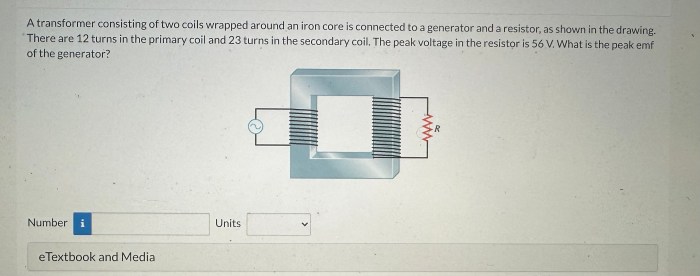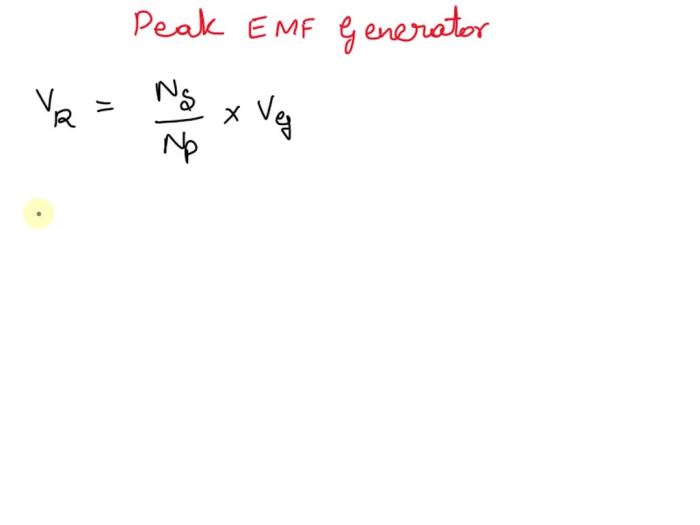A transformer consisting of two coils wrapped – Transformers, consisting of two coils wrapped around a core, are fundamental components in electrical systems. They play a crucial role in transforming voltage and current levels, enabling efficient power transmission and distribution. This article delves into the intricacies of transformers, exploring their types, core materials, winding configurations, and applications.
Understanding the Concept of a Transformer

A transformer is an electrical device that transfers electrical energy from one circuit to another through inductively coupled conductors—the transformer’s coils. Electrical energy is transferred between coils through the magnetic field. The transformer’s coils are wound around a core of ferromagnetic material, such as iron, which concentrates the magnetic field.
Transformers are used to increase or decrease the voltage of alternating current (AC) electricity.
The basic principle of a transformer is electromagnetic induction. When an alternating current flows through the primary coil, it creates a changing magnetic field in the core. This changing magnetic field induces an alternating current in the secondary coil.
Types of Transformers
- Power transformers:These are large transformers used to transmit electrical power over long distances.
- Distribution transformers:These are smaller transformers used to distribute electrical power to homes and businesses.
- Instrument transformers:These are small transformers used to measure electrical current and voltage.
Core Materials and Design
The core material of a transformer plays a vital role in its performance. The most common core materials are:
- Laminated steel:This is the most widely used core material. It is made of thin sheets of steel that are insulated from each other.
- Amorphous metal:This is a newer core material that has a higher efficiency than laminated steel.
- Ferrite:This is a ceramic material that is used in high-frequency transformers.
The design of the core also affects the performance of the transformer. The most common core designs are:
- Shell-type core:In this design, the coils are wound around the outside of the core.
- Core-type core:In this design, the coils are wound around the inside of the core.
Winding Configurations
The winding configuration of a transformer refers to the way the coils are connected to each other. The most common winding configurations are:
- Concentric winding:In this configuration, the primary and secondary coils are wound concentrically around the core.
- Layer winding:In this configuration, the primary and secondary coils are wound in layers around the core.
- Helical winding:In this configuration, the primary and secondary coils are wound in a helical pattern around the core.
Transformer Connections, A transformer consisting of two coils wrapped
The way the transformer coils are connected to each other determines the transformer’s voltage and current characteristics. The most common transformer connections are:
- Delta-delta connection:In this connection, the primary and secondary coils are connected in a delta configuration.
- Delta-wye connection:In this connection, the primary coil is connected in a delta configuration and the secondary coil is connected in a wye configuration.
- Wye-delta connection:In this connection, the primary coil is connected in a wye configuration and the secondary coil is connected in a delta configuration.
Transformer Losses and Efficiency
Transformers are not 100% efficient. There are several types of losses that occur in transformers, including:
- Copper losses:These losses are caused by the resistance of the transformer’s coils.
- Core losses:These losses are caused by the hysteresis and eddy currents in the transformer’s core.
- Stray losses:These losses are caused by the leakage of magnetic flux from the transformer’s core.
The efficiency of a transformer is a measure of how much of the input power is transferred to the output. The efficiency of a transformer is typically between 95% and 99%.
Applications of Transformers
Transformers are used in a wide range of applications, including:
- Power transmission:Transformers are used to transmit electrical power over long distances.
- Distribution:Transformers are used to distribute electrical power to homes and businesses.
- Isolation:Transformers are used to isolate electrical circuits from each other.
- Voltage regulation:Transformers are used to regulate the voltage of electrical power.
Safety Considerations
Transformers can be hazardous if they are not properly installed and maintained. The following safety considerations should be taken into account when working with transformers:
- Electrical hazards:Transformers can be energized with high voltages, so it is important to take precautions to avoid electrical shock.
- Fire hazards:Transformers can overheat if they are overloaded or if they are not properly ventilated, so it is important to ensure that transformers are properly installed and maintained.
- Mechanical hazards:Transformers can be heavy and can cause injury if they are not properly handled.
Questions and Answers: A Transformer Consisting Of Two Coils Wrapped
What is the basic principle of a transformer?
A transformer operates on the principle of electromagnetic induction, where a changing magnetic field in one coil induces a voltage in another coil.
What are the different types of transformers?
Transformers are classified into various types based on their construction, such as core type, shell type, and autotransformer.
What is the role of the core material in a transformer?
The core material, typically iron or steel, provides a path for magnetic flux and influences the transformer’s efficiency and performance.


